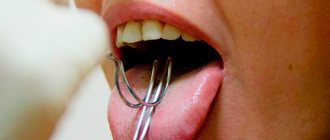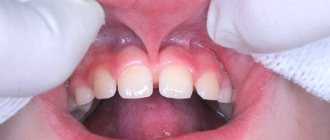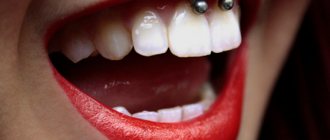According to antiplagiat.ru, the uniqueness of the text as of October 16, 2018 is 99.9%.
Key words, tags: gingivitis, periodontitis, caries, diastema, aesthetic defect, diagnosis, OPTG, periodontal diseases, gum recession, implantation, pulpitis, periodontitis, periostitis, oral examination
In the oral cavity there are inconspicuous, but very important elements of the dental system - the frenulum of the lips and tongue. In a state of normality, that is, anatomical health, they are virtually imperceptible. But if their location or shape is anatomically incorrect, processes such as eating and speech communication can turn into a constant source of discomfort and complexes. Surgical intervention - frenuloplasty - helps to effectively, once and for all, eliminate the existing anatomical defect and the consequences caused by it.
Anatomy of the oral frenulum
There are three frenulums in the human oral cavity: the tongue, the upper lip, and the lower lip. These membranous folds-ligaments, formed from epithelial cells of the mucous membrane and not containing large blood vessels and nerve endings, are additional means of attaching the tongue and lips to the oral cavity and cords - “lifting mechanisms”.
In addition, they are involved in ensuring the correct nutrition process, especially in infancy, in the formation of a correct bite, play a role in the correct functioning of the oral mucosa, facial muscles, speech apparatus, or, as it is also called, the sublingual or lingual ligament - this is a thin a membranous fold of the mucous membrane that runs along the midline of the tongue and, in the anatomical norm, connects it in the middle of the lower part with the floor of the mouth, in the area of the gingival base of the central lower teeth. In fact, the frenulum fixes, that is, holds the tongue, thereby somewhat limiting its mobility, without interfering with its movements and protecting it from retraction. In children aged 5 years, the normal frenulum length is at least 8 mm; at 12-13 years old, when baby teeth are completely replaced by permanent teeth, it is at least 21 mm; in an adult with a mature bite, it is 27-30 mm.
The frenulum of the lower lip (lat. frenulum labii inferioris) is a vertical fold-cord connecting the middle of the lower lip with the gum, and the frenulum of the upper lip (lat. frenulum labii superioris) is the middle of the upper lip with the gum.
In the anatomical norm, the lip frenulum is woven into the center of the gums 5-8 millimeters from the neck of the teeth and is virtually imperceptible.
What to do if the frenulum on the head is torn
The frenulum is a thin longitudinal fold of skin that connects the foreskin to the head of the penis. Normally, in men, such a fold has a quite acceptable length in order to expose the head of the penis during frictional movements without any discomfort or tension. If the frenulum is somewhat shorter than normal, then it causes all sorts of difficulties for patients, is often injured and causes problems in bed.
- If this happens often, then men develop psychological complexes, because they are no longer capable of normal sexual relations.
- If minor tears have become a common occurrence, then scars begin to form at the site of the damage, as a result the head of the penis loses the ability to be exposed, which deprives the patient of the usual orgasmic sensations.
- A short frenulum can rupture under the influence of certain factors, then the man will feel severe discomfort. Typically, such problems occur during sexual intercourse if the sex is harsh, rough, and intense.
In such situations, the skin fold may tear partially or completely. But there is no need to be seriously scared, because this problem is quite common and has a simple solution.
It is almost impossible to predict the likelihood of rupture in advance, because a short frenulum looks quite natural in appearance. Therefore, it is impossible to identify such pathologies in children. In teenagers, the problem becomes more noticeable, and then appropriate measures can be taken.
Most often, the frenulum can break for the following reasons:
- Sharp and rough frictional movements during sexual intercourse or with insufficient hydration of the female vagina, or when trying to break the hymen.
- Congenital pathology in the form of a short frenulum. To avoid possible complications in the future, it is better to treat this pathology in adolescence.
- If the female genital organs are not sufficiently moisturized. This is possible in the presence of various kinds of pathologies, as well as insufficient arousal of the woman before PA.
- Also, the frenulum can rupture due to excessive masturbation.
If a man is faced with a similar problem, then certain measures need to be taken. With such injuries, severe bleeding is observed, which does not always stop immediately, and therefore you need to understand how to treat.
Such a rupture is also not dangerous due to particularly large blood losses, so you need to calm down and get to action:
- You need to press the frenulum to the head or pinch the frenulum with your fingers to stop the bleeding. Keep the damaged fold in this state for about 10 minutes.
- When the bleeding stops, you need to treat the wound with Chlorhexidine, peroxide and other antibacterial and antiseptic drugs.
- There is no need to do the dressing at home, because it is fraught with constriction of the penis and can cause hemorrhage.
- If you are concerned about intense pain, you can apply a cold compress, which will help relieve swelling, stop bleeding and reduce pain symptoms.
- Now you can contact a specialist who will determine the extent of the damage and select the optimal and effective therapy.
Regarding how long it takes for the frenulum to heal, the process is quite fast. But, you should not put off visiting a specialist, otherwise the skin at the wound site will begin to scar, reducing the elasticity of the fold, which in the future can lead to re-rupture. Moreover, the scar is fraught with problems during sexual intercourse, because it significantly reduces orgasmic sensations and provokes the development of complexes of a psychological nature.
Anatomical defects of the lingual frenulum
The most common anatomical anomaly of the frenulum of the tongue is its incorrect location - attachment to the lower part of the tongue is not in the middle, but much closer to its tip. Even with a normal anatomical length, the frenulum in this case is considered pathologically short. Often this defect does not cause noticeable inconvenience, unlike ankyloglossia - perhaps the most serious defect of the frenulum of the tongue. It is characterized by a combination of three anatomical pathologies: the area of attachment of the frenulum is shifted from the middle of the tongue to its tip, the length of the frenulum is significantly less than normal, the elasticity and mobility of the tongue are noticeably reduced. The negative impact of ankyloglossia on the dental system is very significant. Thus, babies suffering from it cannot properly latch onto their mother’s breast, and therefore are not sufficiently saturated 2.
In older children, ankyloglossia “inhibits” the development of the lower jaw, causing tooth displacement. In general, this pathology causes malocclusions, difficulties with breathing and swallowing, contributes to the appearance and development of speech defects, and makes it difficult to eat comfortably.
Ankyloglossia has three main varieties, which differ in the presence of certain anatomical features:
- the frenulum is thin, translucent, attached close to the tip of the tongue, hindering its movements. When the tongue rises upward, its tip acquires a characteristic heart-shaped shape;
- the frenulum is short and thick, “powerful”, restricts the movements of the tongue. When the tongue sticks out forward, its back takes on a hilly appearance, and the tip is lowered down;
- the frenulum is greatly shortened, has a whitish color, the fibers of the frenulum are fused with the muscle fibers of the tongue. This pathology is often combined with clefts of the upper lip or palate, the so-called “cleft palate”, “cleft lip”.
Help from traditional medicine
Using folk recipes and solutions, you can disinfect wounds without resorting to pharmaceuticals. In addition, many of them promote rapid healing of wounds and reduce pain.
Sage tincture. An excellent assistant in the fight against pain during the treatment of various oral injuries. To obtain a miraculous decoction, you need 2 tbsp. pour sage with 2 cups of boiling water and leave for about half an hour. You can rinse 5-10 times a day or as needed.
Sage tincture for rinsing - an effective folk remedy
Chamomile tincture. Chamomile has long been known for its antimicrobial properties. 1 tbsp of dried flowers of this plant is poured with boiling water and infused for 30-40 minutes. The broth must be filtered and used as a rinse solution several times a day.
Bedstraw decoction. This decoction can be used as a tea or rinse. Pour a tablespoon of herb into 1 cup of boiling water and leave for at least 30 minutes.
Alcohol tincture of St. John's wort. It is necessary to prepare 5 parts of 40% alcohol and 1 part of dried St. John's wort herb, let it brew for a while. After this, use 25-30 drops of tincture per glass of water and rinse. This is an excellent remedy for injuries to the tongue and oral cavity.
Using folk recipes, you can save a lot, and the result sometimes exceeds all expectations.
Anatomical defects of the frenulum of the upper and lower lips
The most common is its attachment at the very neck of the teeth. This creates inconvenience when eating, and also significantly complicates oral hygiene, thereby promoting the formation of bacterial plaque, the occurrence of tartar and dental diseases provoked by it - gingivitis, periodontitis, caries.
In addition, an “ingrained” frenulum negatively affects bite and diction. In cases where, after the eruption of the upper front teeth, the frenulum “grows” between them, a diastema is formed - a gap between the crown parts of the teeth in the cervical area. A wide diastema is a significant aesthetic drawback. In addition, a short frenulum of the upper or lower lip in many cases interferes with quality orthodontic treatment and also causes excessive tension, thereby causing increased stress on the dentition. This, in turn, can cause the appearance of various periodontal diseases.
Periodontitis
Periodontitis is an inflammation of periodontal tissues, characterized by progressive destruction of the periodontium and bone of the alveolar process of the jaws.
There are 3 degrees of severity.
- 1st degree – bone destruction up to 1/3
- 2nd degree – bone destruction up to 1/2
- 3rd degree – bone destruction more than 1/2
If the inflammatory process has reached degree 3, then the teeth cannot be saved!!!
Course of periodontitis:
- spicy,
- chronic,
- exacerbation of chronic
- abscess
- and remission.
The prevalence of periodontitis can be:
- localized (the cause may be incorrect position of the teeth, poorly made orthopedic construction or filling)
- and generalized (untimely removal of supra- and subgingival dental plaque, hereditary predisposition, general diseases).
Signs of periodontal disease:
- Bleeding gums.
- Pain when brushing teeth and eating.
- Bad breath.
- Exposing the necks of the teeth.
- The appearance of tooth mobility.
If you have at least one of these points, contact your dentist URGENTLY!
Methods for correcting frenulums
To eliminate anatomical anomalies of the frenulum of the oral cavity, surgical methods are used, among which the main ones are frenotomy, frenectomy and frenuloplasty. These are plastic surgeries, the purpose of which is to bring the frenulum to the anatomical norm.
The surgical method is always selected individually based on diagnostics that determine the characteristics of the defect, as well as taking into account the scale of its impact on the dentofacial system and speech apparatus, the patient’s age, and the general clinical picture.
frenulotomy
is most often performed - dissection of the frenulum in its middle part with special surgical scissors, after which its edges are sutured.
If the frenulum is excessively thick, as well as in cases where this is combined with curettage in the area of the existing diastema, excision, or removal of a section of the frenulum, is performed, sometimes together with the gingival papilla. The operation eliminates existing tension and stabilizes the dentition.
In some cases, frenuloplasty is used to lengthen the frenulum - an operation during which the site of its attachment moves away from the gingival margin or above it. Most often, for this purpose, plastic surgery is performed by counter exchange of triangular soft tissue flaps (according to A.A. Limberg) 3.
In addition to these methods, laser frenulum correction - an operation performed not with a scalpel, but with a laser, which ensures rapid surgical intervention, no bleeding and no need for sutures, low pain response and a short rehabilitation period (less than 7 days).
After frenuloplasty, the rehabilitation period takes no more than a week. At this time, the doctor, as a rule, recommends avoiding hard and hot foods; in addition, in many cases, consultations with a speech therapist, gentle facial massage and myogymnastic exercises are prescribed. In cases where the pathology of the frenulum has affected the change in bite, orthodontic treatment is necessary after surgery.
Rupture, tear, crack of the frenulum
Young men dismiss that the first sexual intercourse is quite painful. A man also “loses his virginity.” This is expressed in a gradual painful stretching of the frenulum. Careless sudden movements can cause injury to a person. What happens if a man’s frenulum is torn or this fold of skin is torn during sexual intercourse? The consequences depend on how deep the wound is, as well as on the first aid actions taken by the person.
Why can a frenulum break?
Even a long bridle can crack or tear. After an injury, scars, microcracks appear, and suppuration may occur. A man can be injured in several cases:
- During violent sexual contact, when control over personal actions is lost.
- With sloppy energetic movements of the partner.
- During a woman's defloration.
- During intimate contact, which is performed “dry”.
- During anal intercourse.
- During intense masturbation.
Why does a man's frenulum break? It is elastic and stretches very well and must withstand significant tension. In fact, everything has a limit. And if you pull the foreskin to the bottom of the penis, a tear in the skin fold may well occur. The same applies to sudden movements - the tension of the frenulum should be gradual, only with sufficient hydration of the genital organs.
What can injury lead to?
It requires distinguishing between a frenulum tear and a rupture. A tear is a minor tissue damage, accompanied by a small amount of blood, but very painful. Rupture is the complete separation of the frenulum from the head of the penis, which occurs with significant bleeding and intense pain.
If a man can control his movements and stops in time, a tear may occur. When you fail to stop in time, a skin fold may rupture. Trauma is dangerous not only due to significant blood loss. A man receives a painful shock, from which he needs to get out of it with the help of medications.
Another possible problem that a man may have is a crack in the frenulum. Provokes the appearance of such pathology:
- Violation of hygienic care of the penis, passion for cleanliness and detergents not intended for intimate hygiene.
- Excessive dryness in the glans, under the foreskin.
- An inflammatory process affecting the urethra and glans tissue.
- Rash caused by allergies.
- Rubbing the penis with synthetic underwear.
Cracks can bleed, fester, and irritate. Pain prevents a man from living a normal sex life and disrupts pleasure.
If a man’s frenulum is torn during sexual intercourse, he may simply get scared and avoid sexual intercourse in the future, making do with self-satisfaction.
What to do if the frenulum ruptures in men
First aid for a tear
What to do if the frenulum is torn? The first step in any injury is to ensure that the treatment is clean. Wash your hands, treat the head of the penis with Miramistin or Septomirin. Use your finger or gauze pad to press the tear site against the head of the penis. It is desirable that the foreskin takes its anatomical place - completely covering the head.
It usually takes 15-20 minutes to stop the bleeding. If a man has not drank alcohol, you can immediately take an analgin tablet to relieve pain. After the blood stops flowing, the penis and frenulum are treated with hydrogen peroxide and bandaged.
Alcohol, brilliant green or iodine should not be used to treat wounds on the penis; these drugs can cause burns to the mucous membrane, significant tissue swelling and increased pain.
If a man's frenulum ruptures, treatment should be prescribed by a doctor. After an injury, a person must observe sexual rest for at least a week. If necessary, antibacterial therapy and vitamins that accelerate tissue regeneration are prescribed.
Possible complications
As a rule, after plastic surgery to correct the frenulum, there are no complications due to the low traumatic nature of the surgical intervention. Normally, the patient may experience minor pain and discomfort after the anesthesia expires, and may experience some discomfort associated with the “acclimation” of the oral cavity to the changed conditions. It is extremely rare that scar deformation may form at the site of sutures, and then repeated surgical intervention is required. This complication is less likely to occur if you consult a qualified, experienced doctor for frenulum correction.
Periodontal disease
Periodontal disease is a degenerative process that affects all periodontal structures. Its distinctive feature is the absence of inflammation on the gingival margin and periodontal pockets. The course of periodontal disease is always chronic.
According to severity they are distinguished:
- a) mild – exposure of tooth roots up to 4 mm;
- b) average – 4-6 mm;
- c) heavy – more than 6 mm.
The prevalence of periodontal disease is generalized.
Flap surgery is a periodontal operation that involves cutting out and folding a mucoperiosteal flap, followed by careful treatment of the surfaces of the roots of the teeth, bone pockets and the inside of the flap.
The advantages of this operation are the complete removal of pathologically altered tissues under full visual control.
Operation stages:
- the mucoperiosteal flap is cut out and folded back,
- subgingival dental plaque and granulation tissue are removed using an ultrasonic tip and curette,
- antiseptic and antibacterial treatment of periodontal tissues,
- if necessary, implantation of bone tissue,
- the flap is then placed in place and secured with sutures.
- Next comes the application of a healing bandage.
- After a week, the sutures are removed.
Curettage is the removal of pathological tissues around the tooth (supragingival and subgingival calculus and granulations). There are closed and open curettage. The essence of these manipulations is to clean periodontal pockets using special instruments - curettes.
In this case, pathological tissues are removed mechanically (with constant irrigation of the surgical field with antiseptic liquids), which are irritants that support inflammation.
It is important to realize that if pathological tissue is not removed, the process will worsen due to the presence of that same irritant. Ultimately, this will lead to the loss of a tooth, which, by the way, may be completely healthy.
Splinting of teeth is a manipulation aimed at combining mobile teeth into a single block, the so-called “splint”. Splinting is most often carried out in the area of the lower incisors, because It is they who suffer more during the generalized process of periodontitis or periodontal disease. To do this, a special wire or an orthodontic retainer is glued to the composite material on the inner surface of the teeth undergoing splinting.
Before installing a splint, it is necessary to carry out professional oral hygiene - remove stones, plaque and thoroughly polish the surfaces of the teeth.
Gumplasty is an operation to correct changes in the appearance of the gingival margin, in the form of excessive growth, or vice versa - recession (reduction in the volume of the gum, accompanied by exposure of the tooth root). Gum plastic surgery is often performed to achieve maximum aesthetic effect. For example, in orthopedic dentistry to increase the clinical height of the crown, when forming an ideal smile. Also after patch surgery, implantation, surgical treatment of hypertrophic gingivitis, etc.
Recession is a decrease in gum volume, accompanied by exposure of part of the root. Recessions can be localized or generalized.
Recessions arising from:
- structural features of the jawbone - when the teeth have a massive root, and the bone in this area is thinned.
- negative microbial flora – the presence of supragingival and subgingival dental plaque. To avoid this, it is necessary to carry out professional oral hygiene at least 2 times a year.
- chronic trauma to the gingival margin. This occurs more often due to improper brushing of teeth (incorrect brush movements, use of brushes with hard bristles, often the use of electric brushes).
- bad habits - using toothpicks, matches to clean the contact surfaces of teeth, biting pencils and other objects.
- external trauma of teeth in the form of dislocations accompanied by chipping of the edge of the socket.
- orthodontic pathology.
During recessions, patients mainly complain about an aesthetic defect and also about increased sensitivity of the teeth. The problem of recession can be solved either orthodontically (if the cause of recession is orthodontic pathology) or surgically.
Surgical methods for treating recession include various types of plastic surgery:
- Moving the pedicle flap
- Relocation of the free flap, with the autograft most often taken from the palate.
- Moving the gingival trapezoidal flap coronally to the defect area.
After surgery, a healing period begins and in less than a month, the patient sees the result.
Indications
Indications for correction of the frenulum of the tongue or lip (upper or lower) may include the following factors: dysfunction of sucking in infants; the patient experiences pain when trying to touch the palate with his tongue; tongue movements are limited; during eating and verbal communication, the processes of breathing and swallowing are difficult, and “fatigue” of the mouth occurs; There is incorrect pronunciation of hissing consonants, sounds “r” and “l”; malocclusion; violations of the aesthetic proportions of the face, tilt of the upper or lower incisors inward or outward; significant diastema; gum recession; discomfort while wearing orthopedic structures; preparation for implantation.
Postoperative recovery
Normally, after the anesthetic wears off, pain occurs in the surgical area. With laser plastic surgery, the discomfort is much less pronounced. In order for the healing of the wound surface to be successful, it is necessary to follow the recommendations:
- Do not eat food for 2-3 hours after surgery.
- Over the next two days, you should eat only soft food, the temperature of which will be optimal. This is necessary so as not to injure the mucous surface of the oral cavity.
- Perform regular hygiene using a soft toothbrush. After brushing your teeth, you should rinse your mouth.
- If the operation was performed on a child, then parents should monitor the hygiene of his teeth.
- At the appointed time, visit a specialist for a preventive examination.
- A week after the intervention, it is necessary to begin performing exercises to strengthen the masticatory and facial muscles. The rules for performing gymnastics will be announced by the doctor.
The first few days after the procedure you will feel some discomfort due to the changes that have occurred as a result of the surgery. However, the discomfort usually goes away after 4-5 days. During this period, the mucous membrane heals, and diction is restored. In order for the interdental gap caused by the incorrect position of the frenulum to disappear, it will take much more time.
Contraindications
Plastic surgery to correct the frenulum is not performed in the presence of blood clotting pathologies, serious mental disorders, during radiation or chemotherapy in the treatment of cancer, during exacerbation of chronic diseases, or in the acute phase of infectious diseases. In the presence of inflammatory processes in the oral mucosa, such as gingivitis, periodontitis, as well as caries, pulpitis, periodontitis, periostitis, the operation is postponed until the disease is eliminated.
Gingivitis
Gingivitis is an inflammation of the gums, caused by the adverse effects of local and general factors and occurring without disruption of the periodontal junction.
Forms of gingivitis:
- a) catarrhal gingivitis - inflammation of the gingival margin. There are chronic and acute forms of catarrhal gingivitis. The acute form of catarrhal gingivitis often develops against the background of some general infection or intoxication. Often catarrhal gingivitis occurs during the period of spring hypovitaminosis, after suffering from influenza and acute respiratory infections.
- b) ulcerative gingivitis is an inflammatory process characterized by the appearance of ulcers and necrotic plaque on the surface of the gingival margin. The development of ulcerative gingivitis is facilitated by the presence of multiple untreated caries and damaged tooth roots. More common during puberty.
- c) hypertrophic gingivitis - leads directly to gum hypertrophy. There is swelling and inflammation. Patients complain of an increase in the volume of the gums, the color of the gums is slightly changed, there is no pain or bleeding of the gums when irritated. The gum has the appearance of a thickened cushion at the base, the gingival papillae are compacted, and the surface is lumpy.
- d) gingivitis of pregnant women and teenage gingivitis, these are those types of gum inflammation that do not occur against the background of hormonal changes in the body.
Severity of gingivitis:
- light,
- average
- and heavy.
Course of gingivitis:
- spicy,
- aggravated,
- chronic.
Age restrictions
Plastic surgery to correct oral frenulum can be performed at absolutely any age in the absence of contraindications. But the most suitable period is the age from 7 to 10 years, when the complete eruption of the four incisors of the upper and lower jaws has completed, and the frenulum itself has not yet reached its “adult” parameters 4. At the same time, in some cases, infancy is more preferable for such surgical intervention, since in infants the frenulum is devoid of blood vessels, anesthesia and sutures are not required, and minor bleeding that may occur after surgery is eliminated independently Pediatric surgery: national guidelines 5.
Diseases of the frenulum of the penis
The main type of deviation in the functioning of the penis is considered to be a shortened frenulum, which can form at any age. Pathologies are divided into two large groups:
Congenital. It is usually discovered in childhood or adolescence during routine examinations by a doctor. This pathology can develop due to an abnormality of intrauterine growth. This disorder is considered safe and treatable. A short frenulum may also be present in premature babies whose genitourinary system has not had time to develop to its normal state.
Acquired. The following factors can provoke this pathology:
- injury during sexual intercourse. Often, tissue tearing can occur due to inadequacy of the partner's vagina or insufficient hydration. The tears become scarred, thereby leading to shortening of the frenulum;
- infectious and inflammatory diseases. The most widely diagnosed include balanoposthitis, urethritis, sexually transmitted infections;
- Sometimes violation of personal hygiene rules contributes to the development of pathology.
Price
The cost of plastic surgery to correct the frenulum of the tongue or lip consists of the cost of a number of dental clinical measures, including: diagnostics (clinical examination of the oral cavity, radiological diagnostic methods, method of surgical correction chosen on the basis of the obtained clinical picture, analysis of the nature of the pathology and the scale of its consequences. Also, the determination of the cost is influenced by the means, equipment and instruments used during the operation, the qualifications of the doctor, and the services of specialized specialists involved in the treatment process if necessary.
Anatomical anomalies of the frenulum of the oral cavity can darken the patient’s life with discomfort, feelings of embarrassment and inferiority. But the problem can be solved with simple surgery. And don’t let this phrase scare you, because plastic surgery of the frenulum of the tongue or lip is a fairly simple and low-traumatic procedure, it is performed using an anesthetic, that is, it is painless, and almost never causes complications. The result - the disappearance of all uncomfortable and painful sensations and the return of self-confidence - is worth it!
According to antiplagiat.ru, the uniqueness of the text as of October 16, 2018 is 99.9%.
Key words, tags: gingivitis, periodontitis, caries, diastema, aesthetic defect, diagnosis, OPTG, periodontal diseases, gum recession, implantation, pulpitis, periodontitis, periostitis, oral examination
*Images: Database of clinical photo protocols of the Professor’s Clinic Edranov 1 https://doctor.by. Encyclopedia of the physical development of the child. Article “Semiotics of congenital and hereditary syndromes” 2 Pediatric surgery: national guidelines. Ed. acad. RAMS Yu.F. Isakova, prof. A.F. Dronova. Moscow, GEOTAR-Media, 2009. 1164 p. 3 Clinical operative maxillofacial surgery. Ed. prof. V.N. Balina, prof. N.M. Alexandrova. St. Petersburg, SpetsLit, 2005, 574 p. 4 Association of lactation consultants “ABC of Motherhood”, St. Petersburg. Article “Ankyloglossia - shortened frenulum of the tongue and upper lip”, Brian Palmer, dental surgeon, Kansas City, USA, 2001) 5 Ed. acad. RAMS Yu.F. Isakova, prof. A.F. Dronova. Moscow, GEOTAR-Media, 2009. 1164 p.
Why does the frenulum hurt?
Tongue diseases are a fairly common problem, but most often quickly solved. The main thing is to choose the right treatment by contacting an experienced specialist.
The mucous membrane under the tongue is highly sensitive; therefore, it can become inflamed and painful even in those people who have never experienced problems with it. It reacts to all kinds of irritants and is also easily damaged.
An abnormal frenulum is injured more often
Causes of pain in the frenulum of the tongue:
| Mechanical injury | When eating solid food or using sharp instruments, there is a possibility of damage to the mucous membrane. |
| Inflammation of the lymph nodes | A number of infectious diseases can lead to inflammation of the submandibular lymph nodes, which will be expressed by pain symptoms in the area of the mucous membranes of the mouth. |
| Allergic reactions | Allergies can be caused by medications, personal care products (toothpaste, mouth rinses) or food products, and the body's reaction will be pain. |
| Overload of the speech apparatus | Loud screams, prolonged conversations and singing can cause an unpleasant feeling of soreness in the frenulum. |
Quite often, pain in the tongue can be echoes of problems in various human organs - the esophagus, teeth and salivary glands.
A lack of vitamins and minerals provokes the development of anemia, a lack of nutrients and B vitamins can also negatively affect the health of the oral mucosa.
An abscess near the frenulum can lead to injury
One of the key rules for pain in the frenulum is not to ignore these painful sensations, because the delicate and sensitive tissues under the tongue perform functions necessary for the body. And it is always easier to prevent a disease than to deal with its consequences and complications.
Why are short bridles dangerous?
Short frenulum in the mouth can cause many unpleasant consequences. The first of them: the baby cannot attach to the breast correctly, so during feeding it expends a lot of effort, but at the same time receives a smaller volume of milk, and it is simply not enough to satiate. This is sometimes the reason for poor weight gain, but quite often mothers and doctors mistakenly look for the cause in a mythical lack of milk, or some disease, although, first of all, it is necessary to look into the oral cavity and assess the condition of the frenulum.
It is very important for parents to know and remember about this problem, because according to statistics, every 14th child has short frenulum in the oral cavity. If you notice this feature in time, then in the future you can avoid many problems and unpleasant consequences - disturbances in nutrition, speech, bite and, accordingly, facial aesthetics.
For the first time, doctors may notice a short frenulum in the baby’s mouth during the first examination, immediately after birth, and if the fact is confirmed, correction is carried out on the spot. This rule applies to a short frenulum of the tongue, but if the frenulum does not interfere with full natural feeding, the frenulum will not be trimmed in the maternity hospital. Symptoms of a short frenulum may appear later - the child may have difficulty pronouncing some sounds, in which case “treatment” will be carried out later, and, as a rule, in tandem with a speech therapist.










